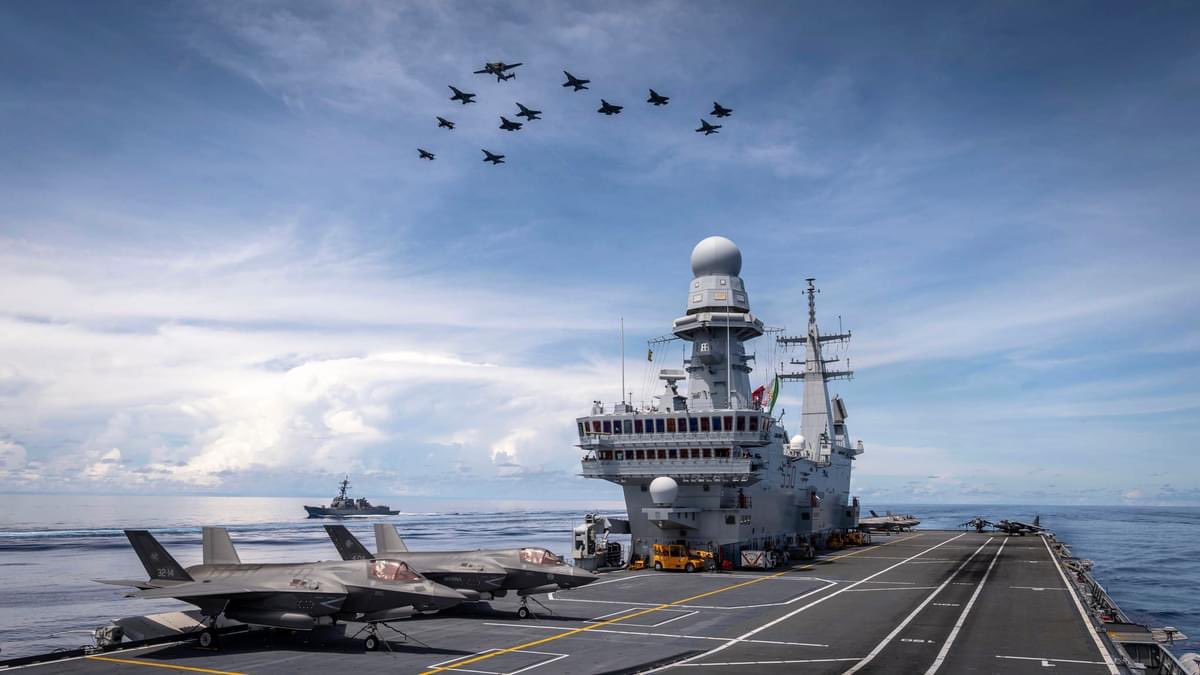Indian Prime Minister Narendra Modi and his Vietnamese counterpart Pham Minh Chinh held wide-ranging talks on Thursday that focused on enhancing cooperation in defense and security, trade and business and other matters.
“Vietnam is our important partner in our Act East Policy and the Indo-Pacific vision,” Modi said, making a joint appearance with Chinh after the two met in New Delhi. “We will continue to cooperate for a free, open, rules-based and prosperous Indo-Pacific.”
The Modi government’s Act East policy focuses on the extended Indo-Pacific neighborhood, with the 10-member ASEAN bloc at its core. The aim is to promote economic cooperation and cultural ties as well as develop strategic relationships with Indo-Pacific countries through continuous engagement at the bilateral, regional and multilateral levels.
“To further strengthen our comprehensive strategic partnership, we adopted a new plan of action today,” the Indian prime minister said, pointing to steps toward defense and security cooperation, including jointly and virtually inaugurating an army software park in Vietnam on Thursday and agreeing on a $300 million credit line to strengthen Vietnam’s maritime security. The army software park at Telecommunications University in Nha Trang, Vietnam, is a facility built with Indian assistance to impart information technology and foreign language training to Vietnamese defense forces
Chinh described Vietnam and India as “close, trusted and faithful” friends who have stood shoulder-to-shoulder throughout history and will do so forever after. He also called for further elevating this bond of friendship.
“The two sides redoubled the importance of ensuring peace, stability, security, safety and freedom of navigation [and] overflight … in the South China Sea,” he said. “A peaceful settlement of disputes based on respecting international law, especially UNCLOS [United Nations Convention on the Law of the Sea] 1982. We agreed to share information and work together to make the South China Sea the waters of peace, stability, friendship [and] cooperation.”
The countries have age-old historical and civilizational ties, which were elevated to a comprehensive strategic partnership during Modi’s visit to Vietnam in September 2016.
According to Harsh V. Pant, vice president of studies and foreign policy at the Observer Research Foundation think tank and a professor of international relations at King’s College London, there are “striking similarities” in the way the countries view foreign relations.
“The template is very similar, which is preserving their strategic autonomy and building multi-alignments with major powers,” he told Nikkei Asia. Pant points out that Vietnam in recent years has fostered a strong partnership with the U.S. despite its turbulent history with that country, and has tried to keep its ties with Russia on an even keel, even as the China factor has become more prominent in its foreign policy over territorial claims in the South China Sea.
China is also a foreign policy concern for India. The neighbors have been in a border standoff in Eastern Ladakh since 2020. In addition, India has been strengthening its ties with the U.S. as a key member of the Quadrilateral Security Dialogue, or Quad, which has made a point of stressing ASEAN’s central role in ensuring a “free and open” Indo-Pacific, a euphemism for containing Beijing’s military and economic influence.
After Russia invaded Ukraine in February 2022, Vietnam adopted a neutral stance. While India has not explicitly condemned Moscow, time and again it has called for resolving the war through dialogue and diplomacy.
Hanh Nguyen, a research fellow at the Yokosuka Council on Asia-Pacific Studies, somewhat echoed Pant’s words regarding the India-Vietnam relationship.
With Chinh’s trip to India, “Vietnam seeks to demonstrate it continues its hedging strategy and (does) not side with any powers,” Nguyen told Nikkei.
Hanoi, in fact, has been careful not to anger Beijing as it diversifies its relations. According to Khang Vu, a Notre Dame International Security Center fellow, Chinh’s visit to India should not upset this strategy.
“Prime Minister Chinh’s visit to India will help Vietnam increase defense relations with an important partner without triggering much skepticism from China, since India is not China’s principal enemy,” Wu said. “Furthermore, Vietnam buying more Indian arms will help it diversify away from Russian arms, whose record on the Ukrainian battlefields has not been convincing.”
At the outset of his statement, Modi expressed deep condolences on behalf of all Indians on the death of Nguyen Phu Trong, Vietnam’s paramount leader who died last month at the age of 80.
Modi said he and Chinh also resolved to pay attention to the so-called green economy as well as new and emerging technologies.
The sides signed several cooperation pacts — in customs capacity building, agriculture research and education, the legal field, radio and television, and medicinal plants.
On the trade front, Prime Minister Chinh on Wednesday said at an event organized by the Federation of Indian Chambers of Commerce and Industry and the Vietnamese embassy in New Delhi that the countries should work together to raise bilateral trade to $20 billion “going forward,” up from $14.8 billion currently.
“I would like to ask that we expand our market access to each other’s products such as through … a suitable FTA between Vietnam and India,” he said. “Of course, we need to discuss this, we need to sit together … we need to make sure that our benefits are shared with each other.”
He added, “For Indian businesses, I hope that you would continue to invest and invest more in Vietnam [and] cooperate with us in training high-quality human resources” especially in the areas of semiconductors, technology innovation, green hydrogen, pharmaceuticals, renewables and biotechnologies.
India possesses expertise in pharmaceuticals and communications, which remain key focuses of the discussions. In electric vehicles, meanwhile, Vietnam’s homegrown VinFast automaker is building a factory in India while looking to replicate India’s information technology prowess.
Chinh arrived in New Delhi late Tuesday at Modi’s invitation; it is his maiden trip as the head of the Vietnamese government and wraps up on Thursday evening.
It is the first time in a decade for a Vietnamese prime minister to visit India.





